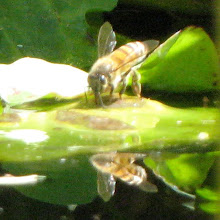I've been learning to tell time by what color the eucalyptus leaves are outside my bedroom window. If they are warm orange in the morning sunlight, then it is 6am or so. By the time 7am rolls around, the orange is gone and the leaves are a warm green, bathed in yellow light. If it's after 8am, then the heat of the AZ sun is upon us. The eucalyptus is its usual silvery green color, the light is bright and the blue sky is already starting to fade from the bleaching effects of the sun.
I used to have no idea what color the leaves were at 6am, but am really enjoying shifting my living to "normal" hours. Wrigley and I go for a quick walk in the park before 8am, when it's too hot. I might even get to a 7:30 am yoga class one of these days!
Last night I dreamt that I was cracking eggs into a bowl, enjoying each one as it "blooped" into my hand first. Cupping one of the gelatinous forms, I felt a heartbeat. It was an amazing dream-land discovery, and I held this raw egg yolk form in my palms and just felt its heart beat. No explanation for it, just revelry.
I've been translating french auction catalogs into a database. Yesterday I translated some paintings by an artist, Henri Epstein, whose date and place of death were listed as 1944, Auschwitz. He has stuck in my mind and I wonder how many more artists like him were lost among the dead there. Henri was born in Lodz, Poland, which I now know of as it's where the Polish Fiber Triennial takes place, where several of my artists were included this year.
Henri Epstein’s father was a bookshop owner who died when he was three. His mother raised him and encouraged his encouraged his precocious interest in painting. He studied first at the Jakub Kacenbogen Drawing School in Lodz, then at the Fine Art Academy in Munich until the age of nineteen. In 1912 he first visited Paris, after which time he served in the Polish army.
In 1913 he returned to Paris and became a member of La Ruche until 1938, taking courses at La Grande Chaumiere Academy. His initially fauvist style evolved later towards expressionism.
In 1921, Epstein illustrated Gustave Coquiot’s work "Vagabondages" (Ollendorff) and in 1926 the work "Les Rois du Maquis" by Pierre Bonardi (André Delpeuch). He most probably participated in the inaugural edition of the jewish art review Makhmadim, published first by La Ruche and then by La Renaissance, for which he wrote articles in yiddish. Epstein bought a farm near Épernon which served both as an atelier and a refuge during the Occupation.
On 23 February 1944, he was arrested in Epernon by three Gestapo agents. Despite the efforts of his friends and his wife (the painter George Dorignac’s daughter) he was interned in Drancy on 24 February 1944 and deported on 7 March 1944 on convoy n°69. He was assassinated in Auschwitz.
From: http://www.ecoledeparis.org
Subscribe to:
Post Comments (Atom)


No comments:
Post a Comment